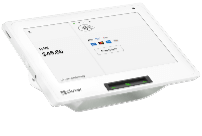Retail Rates
3.5% + $0.15
Merchant One provides credit card processing and various other merchant services for multiple business types, from small eCommerce stores to restaurants and businesses with physical locations. They provide state-of-the-art POS systems and payment terminals, and claim new merchants can be set up and accepting credit cards within just 24 hours of applying. Plus, they have a 98% approval rate, so chances are your application will be approved – even if you have less-than-perfect credit.
Get Rates
Clover is known for their POS systems, but did you know that’s just one aspect of their small business merchant services? They also provide credit card and other forms of payment processing, gift card and loyalty programs, and financial services, offering secure and reliable same day funding with 24/7 dedicated support. Clover connects business owners to the best-in-class services that help build a powerful online presence for their clients.
Get Rates 1For new Clover Business Solutions customers only. To be eligible, merchant must: Activate account by submitting a batch of $25 or more in sales within 30 calendar days from approval date, and processing $10,000 or greater in card transactions within the first four billing cycles. Requires a 3-year contract. Offer expires June 30, 2024.
1Get a $450 statement credit

when you buy Station, Mini or Flex
Sekure has a wide network of popular credit card processors, which allows them to provide you with unbiased advice and to ensure you’re getting a great deal for your specific business. Get access to some of the latest POS equipment and be up and running in about 48 hours.
Get Rates- Accept chip cards and NFC payments
- Countertop point-of-sale
- Available in UK & Canada
- Digital and printed receipts
- Payment dispute assistance
- Accept credit & debit cards
- Mobile processing
- Online payments
- Reporting solutions
- Terminals & chip card readers
- Accept payments in-store and online
- Accept most major cards
- Terminal solutions
- Countertop terminals
- Online POS solutions
- POS hardware
- POS apps
- Accept credit cards
- Reporting tools and apps
- Inventory solutions
- Mobile & In-Store rates start at 2.7%
- No high-risk merchant solutions
- Virtual Terminal: $30/mo + fees
- Recurring Billing: $10/month
Square
Costco
Retail Rates
1.22% + $0.12(qualified transactions)
Chase
Retail Rates
1.99% + $0.15(reported)
Bank of America
Retail Rates
Interchange $0.20 + 2.7%PayPal
Retail Rates
1.55% - 2.7%
- Retail/in-store rates: 0.29% - 1.55%
- Fast set up + No setup up fees
- State-Of-The-Art Technology
- High-risk merchant solutions
- Insights to Grow Your Business
- 24/7 Customer Service
*About our Service: This site is a free online resource that offers valuable content and comparison features to consumers. To keep such resource 100% free for consumers, CreditCardProcessing.net receives advertising compensation from some of the companies listed on this page. Such compensation impacts the location and order in which such companies appear on this page. All such location and order are subject to change. CreditCardProcessing.net does not include all credit card processing sites available to consumers in the marketplace.
Credit cards are heavily favored by consumers who make online purchases. In fact, 48% and 47% of survey respondents indicated they prefer to use credit cards, over debit cards and PayPal, for online shopping and online travel purchases, respectively.
Source: TSYS U.S. Consumer Payment StudyCredit card payments registered the highest growth rate of 10.2% among the core payment types.
Source: Federal Reserve Payments Study 2017U.S. Merchants paid $116.43 billion in credit card processing fees in 2020.
Source: The Nilson Report 2020Some work for retail with a credit card machine or phone orders with a virtual terminal. There are processors on the list for large transactions, iPad POS, or are suitable for high-risk businesses.


